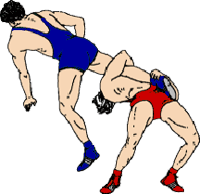In a sport known for its fierceness and physicality, Woodside’s Shaheem Brown possesses an uncommon aura of silence. At the Peninsula District championship last month, a first glimpse of Brown found the senior in the bleachers at Phoebus High School, headphones on, in total silence.
In this case, he was getting ready for a semifinal match. However, a later meeting presented a relatively soft-spoken young man who chooses his words carefully.
When asked about his penchant for appearing to be
quiet, yet intense, Brown’s answer was well constructed, and humorous.
“Everybody at school asks me all the time if I’m
mad. But if you get me in a conversation, I won’t stop.”
Brown did note his change in appearance during
competition.
“When it comes time for a match, I’m getting ready.
Basically, I am thinking that I know what I have to do.”
This quiet intensity has made Brown one of the more
accomplished grapplers in the Peninsula District. Last year, he was the
district champion at the 171-pound division. In the recently completed season,
Brown moved up the 182-pound class and found a tough opponent for the Peninsula
final in the form of Hampton’s Chris Lee., who entered the match undefeated at
9-0. The match was close at 3-2 after the first period, but a pair of takedowns
in the second gave Lee an 8-4 advantage, and he held the momentum for a 10-5
decision.
Brown went on to win two matches at the Eastern
region meet, only to eventually fall in the double elimination competition.
Still, his final season record was an impressive 21-7, giving him a 35-12 mark
for the final two years with the Wolverines.
But his start with the sport started three years ago
at another school. While attending Bruton as a ninth grader, Brown’s older
brother Shamar had decided to try out for wrestling. Looking for an ally in the
sport, he recruited Shaheem to try out.
So, your brother and you got to wrestle together for
a few years?
“Well no,” said Brown. “He only wrestled one year.
Broke his hand.”
Woodside wrestling coach Doug Camp has his own
recollections of meeting Brown.
“Since the first time that he walked
into our mat room he has stood out from the rest as a natural leader. Since
taking over the wrestling program he is my first District Champion. Personally,
his drive to become better at wrestling or whatever he puts his mind to is
always evident. Watching this young man grow these past three seasons has been
a pleasure, I know he's going to go far in life.”
Even after losing his brother as a teammate, the
younger brother stuck it out and wrestled for all four years of high school.
There might be an opportunity to extend his season as preliminary talks are in
place to begin a Peninsula vs. Bay Rivers wrestling tournament at the
conclusion of each season. While the intention is to begin this event soon, parts
of the talks have included an attempt to start the meet this year.
Would Brown be interested in perhaps wrestling
against Andrew Junio of Tabb?
‘I probably would not,” answered Brown, again
wasting no time in getting to the point, but speaking of the match itself, not
the opposition. But his reasoning makes perfect sense. “I messed up my leg
after regionals. Actually, it had bothered me all season, but I must have done
something else to it that day.”
But his career on the mat may not be over. Brown’s
plans, to no surprise, are well defined. His outlook on wrestling mirrors the
choices he is currently making in life.
“I like having competition. I am always trying to
get better.” Quiet, but driven.
His choice of colleges has narrowed to the
University of Maryland or the Florida Institute of Technology. A future stint
with the Air National Guard waits. There may still be time for wrestling.
“I may go on to club wrestling. But, if I go to
Maryland, I might try to make the team as a walk-on.”
With the dedication and preparation that he puts
into every other aspect of his life, there is every reason to believe that if
any wrestler could walk-on and compete for a nationally recognized program, it
could be the quiet, determined young man from Woodside.





